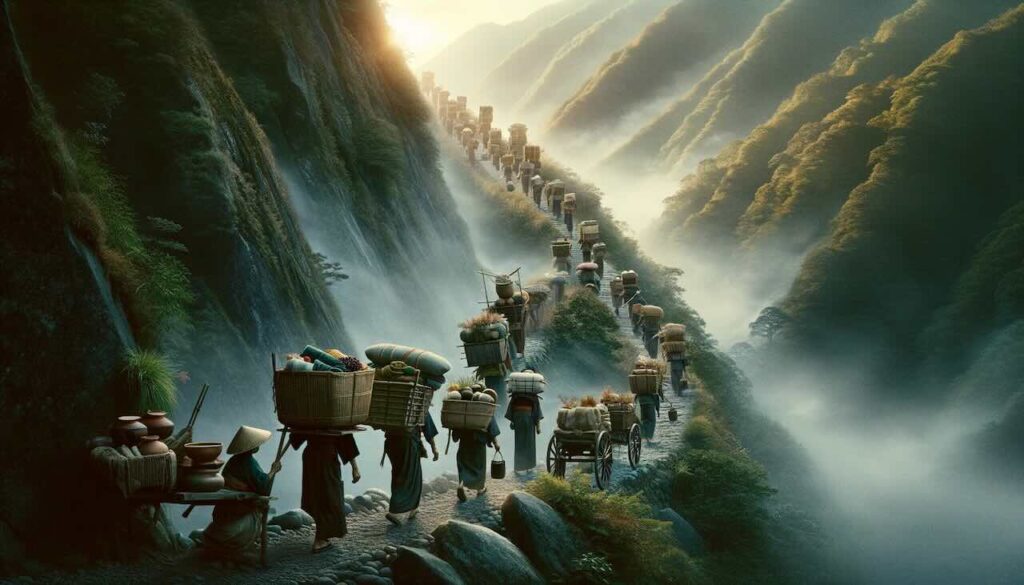When we think of the Edo period (1603–1868), we often imagine a self-contained, rigidly hierarchical Japan under the Tokugawa shogunate. But beneath this political stability, a rich and dynamic flow of commerce and culture tied Japan’s regions together. At the heart of this flow was a phenomenon known as kudari-mono (下り物) — literally, “downward goods.”
Kudari-mono represented far more than simple trade: it was the cultural lifeline that connected the imperial legacy of Kyoto and the commercial powerhouse of Osaka with Edo, the rapidly growing capital of Tokugawa rule.
What Is Kudari-mono?
Kudari-mono refers to goods transported “down” from the western Kansai region — particularly Kyoto and Osaka — to Edo (modern-day Tokyo). In traditional Japanese geography, Kyoto, as the imperial and cultural center, was considered “higher,” while Edo, though powerful politically, was viewed as geographically and culturally “lower.”
This downward flow of goods wasn’t just commercial — it carried Kyoto’s refined court culture, Osaka’s merchant expertise, and Kansai’s long-established traditions directly into the heart of Edo’s booming metropolis.
Kudari-mono vs. Meibutsu: A Subtle but Important Distinction
It’s easy to confuse kudari-mono with meibutsu (名物), or regional specialties, but there are key differences:
- Meibutsu refers to famous products that symbolize a particular region (e.g. Nishijin textiles from Kyoto, kabayaki eel from Osaka).
- Kudari-mono is a broader category that includes both meibutsu and more ordinary goods sent from Kansai to Edo.
In short: while all meibutsu sent to Edo were kudari-mono, not all kudari-mono were necessarily meibutsu.
The Diverse World of Kudari-mono: What Flowed Downstream?
The variety of kudari-mono illustrates Kansai’s cultural, economic, and artistic richness:
1. Textiles: Kyoto’s Luxurious Fabrics
- Nishijin-ori silk from Kyoto was highly sought after in Edo for kimono fashion among samurai, wealthy merchants, and courtesans.
- These fine fabrics reflected centuries of imperial court aesthetics brought into Edo’s rising consumer culture.
2. Ceramics: Fine Wares for Tea and Dining
- Kyō-yaki and Kiyomizu-yaki pottery from Kyoto, along with Shigaraki and Seto ware, decorated Edo’s tea rooms and high-end households.
- These ceramics embodied the sophisticated wabi-sabi aesthetic central to Japanese tea culture.
3. Literature and Stationery
- Kyoto’s advanced publishing industry supplied Edo with woodblock-printed books on poetry, Confucian philosophy, medicine, and fiction.
- Edo’s growing intellectual class eagerly consumed these publications, fueling Edo’s own literary and scholarly developments.
4. Medicine and Beauty Products
- Kyoto’s apothecaries provided herbal medicines, while Osaka’s thriving cosmetic industry shipped soaps, powders, and perfumes to Edo’s urban consumers.
5. Culinary Delights
- Osaka’s famous grilled eel (kabayaki), premium soy sauces, miso pastes, and confectionery specialties delighted Edo’s food-loving population.
- These food imports profoundly influenced Edo’s evolving culinary identity.
The Cultural Significance of Kudari-mono
Kudari-mono was far more than a logistics operation — it was a conduit of cultural transmission that helped Edo absorb, reinterpret, and transform Japan’s classical traditions.
1. Aesthetic Refinement
- Edo’s fashion, interior design, and artistic taste were heavily shaped by the refined sensibilities of Kyoto’s aristocratic culture.
- The influence of kudari-mono elevated Edo from a provincial political center into a sophisticated urban culture of its own.
2. Culinary Fusion
- Kansai ingredients and cooking methods helped create Edo’s distinct culinary traditions, blending regional flavors into new forms.
3. Intellectual Exchange
- The influx of books and scholarly materials allowed Edo’s merchant and samurai classes to develop their own intellectual circles, contributing to the flowering of Edo’s urban culture.
4. Markers of Social Status
- Owning or consuming certain kudari-mono became a clear marker of wealth, taste, and cultural sophistication in Edo society.
5. Economic Integration
- The constant flow of goods strengthened economic bonds between eastern and western Japan, laying the foundation for a unified national economy long before Japan’s modern industrialization.
The Infrastructure Behind Kudari-mono: Japan’s Early Distribution Network
Kudari-mono depended on Japan’s sophisticated Edo-period transportation system:
- The Tōkaidō and Nakasendō highways connected Edo to Kyoto and Osaka.
- Coastal shipping routes along the Seto Inland Sea and Pacific Coast accelerated delivery of goods.
- Post stations (shukuba) ensured efficient handoffs between carriers.
- Private merchants, guilds, and specialized freight services coordinated shipments.
In many ways, Edo-period Japan functioned as a well-integrated commercial nation long before modern railroads or industrialization.
The Legacy of Kudari-mono Today
The echoes of kudari-mono are still deeply embedded in modern Japanese culture:
- Kyoto’s craftsmanship continues to symbolize refinement in Japanese aesthetics.
- Osaka’s culinary traditions remain enormously popular across Japan, particularly in Tokyo.
- The east-west cultural dynamic between Tokyo and Kansai, established during the Edo period, still shapes national identity today.
- Japan’s modern logistics industry, known for its precision and speed, can trace part of its DNA back to these early distribution networks.
Summary
Kudari-mono was not merely the movement of goods—it was the downward flow of cultural prestige, artistic mastery, intellectual capital, and economic power from Kansai to Edo. Through these goods, Edo absorbed the legacy of Japan’s imperial past while forging its own dynamic urban culture.
By examining the story of kudari-mono, we see how commerce acted as a cultural bridge, uniting diverse regions and helping transform Japan into a modern nation. In every book printed, kimono woven, or eel grilled, we glimpse the rich interweaving of Japan’s regional traditions into a shared national identity.


